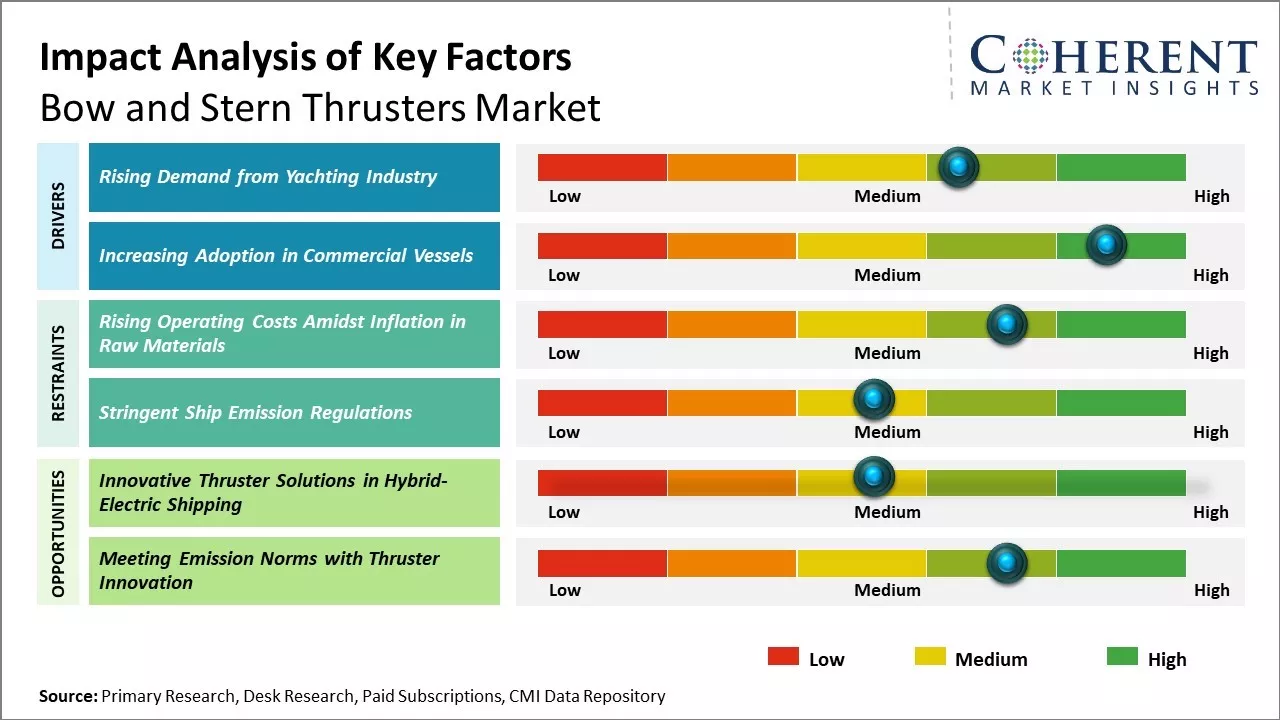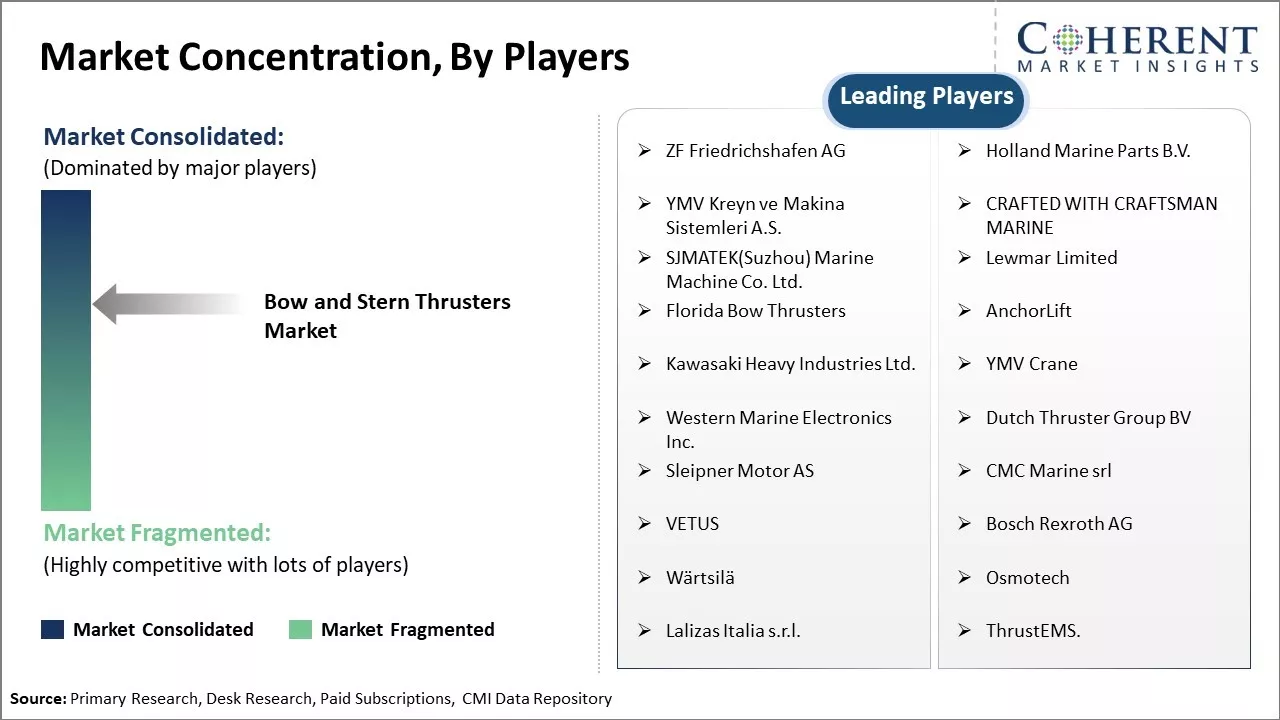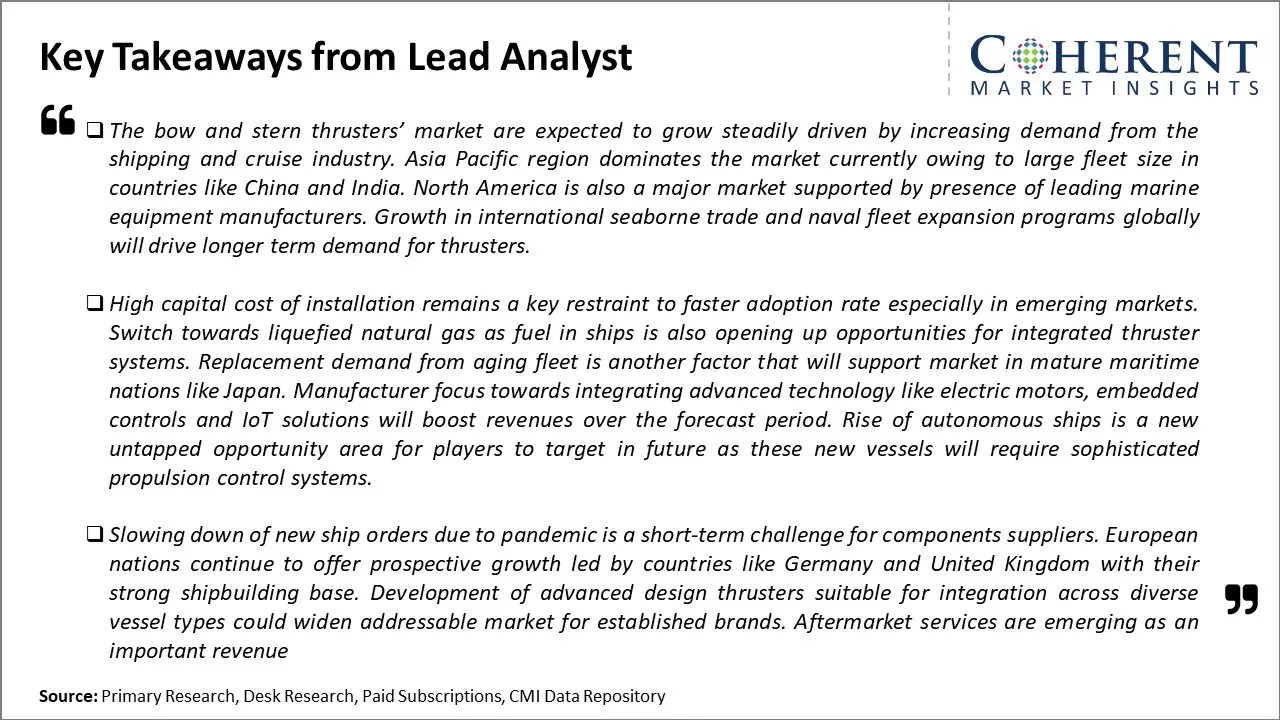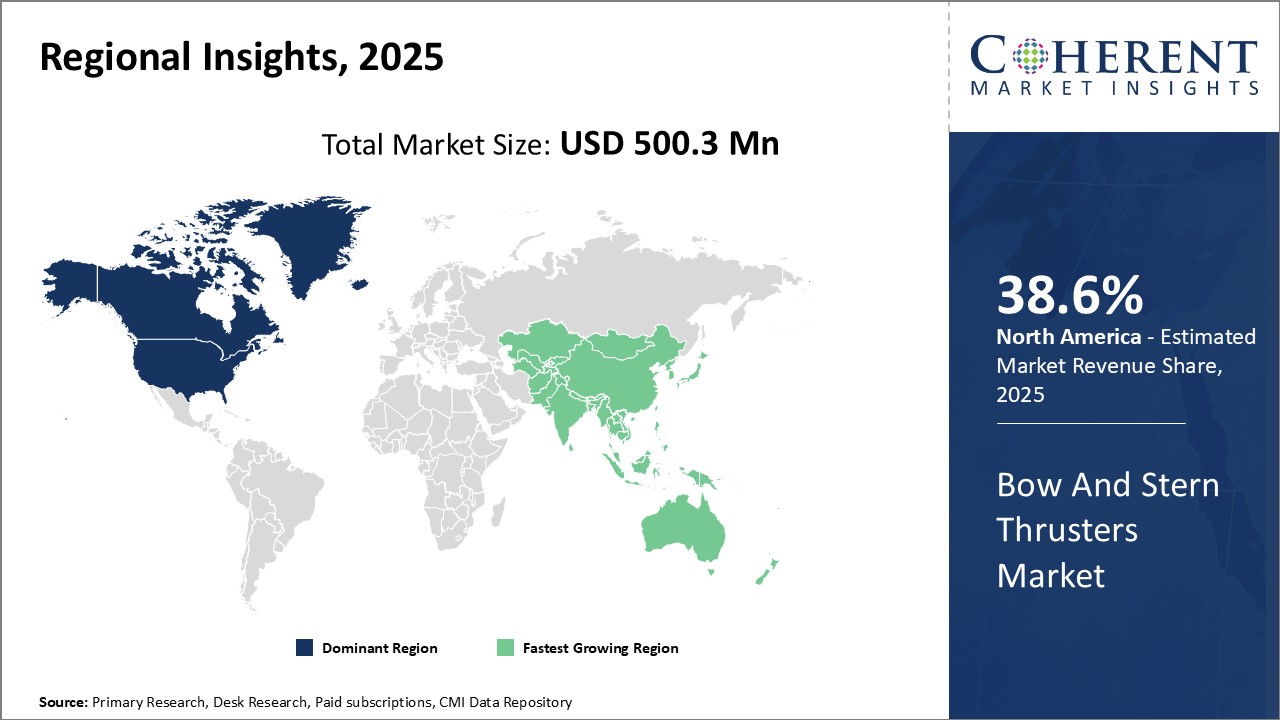Bow And Stern Thrusters Market Size and Trends
The bow and stern thrusters’ market is estimated to be valued at USD 500.3 Mn in 2025 and is expected to reach USD 695.1 Mn by 2032, growing at a compound annual growth rate (CAGR) of 4.8% from 2025 to 2032.

Discover market dynamics shaping the industry: Download Free Sample
The bow and stern thrusters market is expected to witness positive growth over the forecast period. The increasing demand for technologically-advanced and efficient maneuvering control systems from commercial vessels is driving the demand for bow and stern thrusters. Additionally, the growing global marine tourism and transportation industry is also contributing to the growth of the market. Ship owners are increasingly focusing on enhancing ship maneuverability, safety, and optimizing fuel consumption which is further propelling the adoption of bow and stern thrusters. Growing international trade and commerce activities will further augment the demand for commercial vessels, which, in turn, will drive the bow and stern thrusters market growth during the forecast period.
Rising Demand from the Yachting Industry
The yachting industry has been witnessing steady growth over the past decade owing to rising high-net-worth individuals’ population and increasing disposable incomes. Yachts are becoming a status symbol and means of luxury for wealthy customers. Manufacturers are introducing various sophisticated and technologically advanced features in yachts to attract more customers. Bow thrusters and stern thrusters have become an important equipment installed in most of the yachts and boats to assist in docking. They help in precise maneuvering of large and heavy yachts while berthing and give confidence to the captain and crew during operations in confined spaces. With growth in super yachts and mega yachts segment, the demand for thrusters is also rising. Their installation enables easier navigation of yachts in marinas and harbors. This has significantly boosted the sales of bow thrusters as well as stern thrusters. Going forward, further income growth, increasing passion for boating as leisure and vacation activity is expected to drive new yacht sales which will complement Bow and Stern Thrusters Market.
In November 2022, VETUS, a boat systems designer, introduced its latest BOW PRO Boosted thruster units for 400-mm tunnels, in DC thruster power. The BOW PRO Boosted 385 and BOW PRO Boosted 420 are the most powerful fully proportional brushless thrusters available, compatible with 48VDC. These new models expand VETUS' advanced BOW PRO lineup, catering to larger boats ranging from 25m to 40m (82ft to 131ft). With power outputs of up to 385kgf (BOWB385) and 420kgf (BOWB420) at 48V, these units maintain the efficiency and innovation of VETUS BOW PRO thrusters. Users can benefit from precise proportional control during docking or maneuvering without concerns about overuse or overheating. The products were first showcased at METSTRADE 2022.
Market Concentration and Competitive Landscape

Get actionable strategies to beat competition: Download Free Sample
Increasing Adoption in Commercial VesselsApart from yachting and leisure boats, commercial vessels are also adopting bow thrusters and stern thrusters in large numbers. Their installation helps in efficient cargo operations, reduced turnaround time, and safety during berthing. With rising global trade, the freight traffic has been growing necessitating newer cargo ships and tankers. Shipping companies are opting for technologically-advanced designs with features like thrusters that enhance productivity. Government regulations in many countries also mandate installation of thrusters in tankers and containers above certain tonnage for safe navigation in ports. Manufacturers are introducing specialized thruster designs suitable for tough conditions faced by dredgers, tugboats and offshore support vessels. Growing offshore energy industry has also boosted demand for offshore service vessels which is a key growth area. Even ferries and passenger vessels engaged in short sea shipping are recognizing benefits of maneuverability offered by thrusters. Strict emission norms are further driving adoption of efficient propulsion systems having auxiliary thrusters. This wide application base across commercial marine industry ensures steady demand growth for bow and stern thrusters’ market over the long run.
In January 2023, Ulstein, a company specializing in ship designs and construction, officially began the construction of Acta Marine's CSOVs (Construction Service Operation Vessels) by initiating the steel cutting process at their shipyard. These 89-meter-long vessels will feature a motion-compensated crane and gangway provided by SMST, ensuring safe personnel transfer even in significant wave heights up to 3.0 meters. With accommodations for up to 135 people, the CSOVs also incorporate Methanol MDO/HVO engines and a battery power storage system for enhanced energy efficiency and CO2 reduction. These vessels stand out as the first to adopt Ulstein's TWIN X-STERN® design, characterized by two sterns and main propeller units at each end. This design, along with thrusters and a symmetrical hull, leads to lower energy consumption, reduced motions, improved maneuverability, and enhanced comfort. The innovative concept not only decreases noise levels on board but also has the potential to save significant energy during operation.

To learn more about this report, Download Free Sample
Market Challenges: Rising Operating Costs Amidst Inflation in Raw MaterialsHigh raw material prices due to inflation have increased operating costs for manufacturers. Strict environmental regulations on emissions from ships pose technical challenges to develop new eco-friendly thruster designs. Declining global trade volumes have postponed new ship building plans, reducing immediate demand. Geopolitical tensions in some Asian and European markets have made certain regions risky for expansion.
Market Opportunities: Innovative Thruster Solutions in Hybrid-electric Shipping
As international trade recovers from the pandemic, the demand for cargo ships is expected to rise steadily driving need for new thrusters. Strict emission norms will necessitate retrofitting older ships with greener propulsion alternatives. Innovation in hybrid-electric and fully autonomous ship technologies provide a potential uplift to the bow and stern thrusters market.

Discover high revenue pocket segments and roadmap to it: Download Free Sample
Insights, By Material Type: Reliability and Durability Drive the Demand for Tunnel Bow and Stern ThrustersThe tunnel bow and stern thrusters segment accounts for the largest share of 38.7% in the bow and stern thrusters’ market. Tunnel thrusters have emerged as a highly reliable and durable propulsion solution for maritime vessels. Their enclosed impeller design protects critical components from external marine hazards like debris and corrosion. In comparison with other open propeller variants, tunnel thrusters offer lower maintenance needs and a longer operational lifespan.
The self-contained tunnel protects the propulsion mechanism across diverse operating environments. Vessels can deploy these thrusters in rivers with vegetation or in ocean areas with floating garbage with less risk of damage. The enclosed impeller cavity also makes tunnel thrusters better suited for applications involving marine growth on hulls. Without requiring below-waterline inspection and cleaning, they deliver consistent thrust over long usage periods.
For commercial ship operators, the high reliability of tunnel thrusters directly translates to lower total cost of ownership. Downtime for repairs is infrequent, allowing for high asset utilization. Maintenance contracts emphasize scheduled overhauls instead of emergency repairs. The dependability of tunnel thrusters is especially important for applications like tugs and offshore support vessels with critical dynamic positioning needs. It boosts job site efficiency and safety by keeping vessels operational around the clock.
Externally Mounted Bow and Stern Thrusters are devices installed on the outside of a boat to provide additional maneuverability. Bow thrusters help the front of the boat turn, while stern thrusters assist in turning the rear. They enhance control during docking and low-speed maneuvers. Similar to externally mounted thrusters, Retractable Bow and Stern Thrusters can be extended or retracted as needed. When not in use, they can be retracted to minimize drag and improve the boat's efficiency. This feature is useful for vessels that want the benefits of thrusters without the constant resistance. Instead of traditional propellers, water jet thrusters use jets of water for propulsion. These thrusters offer high maneuverability, making them suitable for precise movements in tight spaces. They are commonly used in vessels where traditional propellers may not be ideal.
Insights, By Application - The Boat Segment Captures the Highest Share of the Overall Bow and Stern Thrusters Market
Recreational and fishing boats rely heavily on supplementary propulsion from bow and stern thrusters for precise maneuvering. Unlike ships with ample deck space, boats have restricted footprints requiring sharp turning capabilities. Thrusters enable operators to pivot boats on the spot and ease navigation in tight marinas or close shoals.
Leisure boating continues gaining popularity as a hobby and tourism activity. New boat registrations indicate growing consumer interest, especially for medium and large fishing and pleasure boats. Established markets in North America and Europe continue expanding their boating infrastructures with new marinas. Meanwhile, regions like Asia Pacific are witnessing rising discretionary spending power and coastline development conducive for boating.
The boat segment is also driven by aftermarket installations on the expanding in-use fleet. As boats age 3-5 years after purchase, many owners upgrade original propulsion systems to enhance handling performance for changing needs. Stern thrusters allow fishing boats, for example, to hold position over fishing spots subjected to tidal changes. Their installation extends the utility of existing boats and delays new replacement cycles. Various vessels play vital roles in different aspects of the maritime industry. Barges serve as a cost-effective means to transport bulk commodities like coal or grain. In global trade, ships are crucial, facilitating the movement of goods across countries and continents; they include container ships, bulk carriers, and oil tankers. Yachts, associated with a high-end lifestyle, are utilized for private cruises, vacations, or corporate events and range in size from smaller sailing yachts to large motor yachts. Tugboats play an essential role in guiding larger ships safely into and out of ports, providing the necessary power and control for safe navigation in confined areas. Additionally, Autonomous Underwater Vehicles (AUVs) are deployed for various tasks, such as underwater surveys, inspections, and research. AUVs offer efficiency and cost-effectiveness in collecting data and performing tasks in underwater environments without the need for human divers. Each of these vessels contributes uniquely to the efficiency and functionality of the maritime industry.
Regional Insights

Need a Different Region or Segment? Download Free Sample
North America is estimated to established itself as the dominant region in the global bow and stern thrusters market with 38.6% market share in 2025. This can be attributed to the presence of major OEMs and component manufacturers based in countries like the U.S. and Canada. Companies such as Schottel, Veth Propulsion, Side-Power, and HRP along with engine manufacturers Cummins and Caterpillar have a strong foothold in the region, catering to both domestic as well as international demand. In addition, the developed maritime infrastructure and expertise in shipbuilding further strengthens the industry ecosystem in North America. The naval applications along the U.S. coast primarily drive the demand for heavy-duty and customized thrusters.
Asia Pacific represents the fastest growing regional market for bow and stern thrusters globally with a CAGR of 7.84%. The growth can be accredited to factors like rising maritime trade, growing number of domestic and international ports, and increased shipbuilding contracts in major economies like China, Japan, and South Korea. These countries are focusing on developing indigenous thruster production capabilities through joint-ventures and in-house R&D to gain self-sufficiency over imported components and systems. Further, the cost competitiveness across the component supply chain along with availability of skilled workforce provide an impetus for international original equipment manufacturers (OEMs) to establish local manufacturing bases in the region.
Countries such as India and Indonesia are also emerging as strong markets, aided by the government initiatives to expand coastal transportation and modernize the inland waterways system. The local availability of expertise in areas such as ship design and retrofitting offers opportunities for thruster manufacturers and ship owners to customize their requirements. The regional prices are influenced by the high domestic production across different power ranges, although import dependence still persists for high-powered bow thrusters.
Market Report Scope
Bow And Stern Thrusters Market Report Coverage
| Report Coverage | Details | ||
|---|---|---|---|
| Base Year: | 2024 | Market Size in 2025: | USD 500.3 Mn |
| Historical Data for: | 2020 To 2024 | Forecast Period: | 2025 To 2032 |
| Forecast Period 2025 to 2032 CAGR: | 4.8% | 2032 Value Projection: | USD 695.1 Mn |
| Geographies covered: |
|
||
| Segments covered: |
|
||
| Companies covered: |
ZF Friedrichshafen AG, Holland Marine Parts B.V., YMV Kreyn ve Makina Sistemleri A.S., CRAFTED WITH CRAFTSMAN MARINE, SJMATEK(Suzhou) Marine Machine Co. Ltd., Lewmar Limited, Florida Bow Thrusters, AnchorLift, Kawasaki Heavy Industries Ltd., YMV Crane, Western Marine Electronics Inc., Dutch Thruster Group BV, Sleipner Motor AS, CMC Marine srl, VETUS, Bosch Rexroth AG, Wärtsilä, Osmotech, Lalizas Italia s.r.l., and ThrustEMS. |
||
| Growth Drivers: |
|
||
| Restraints & Challenges: |
|
||
Uncover macros and micros vetted on 75+ parameters: Get instant access to report
Bow And Stern Thrusters Industry News
- In February 2022, VETUS, a comprehensive boat systems designer, launched an entirely electric propulsion package. This comes two decades after the debut of the EP2200. The new system, named "E-DRIVES," is a complete solution that includes various modules, solidifying VETUS's reputation as a leading creator of boat systems.
- In November 2021, VETUS, a designer of complete boat systems, expanded its advanced BOW PRO units with the introduction of the BOW PRO Boosted 300 series. This new series includes the BOWB285, BOWB300, and BOWB320 thrusters, which are the most powerful in VETUS's BOW PRO lineup and the first in the 300mm tunnel range. These thrusters are suitable for boats up to 30m (approximately 100ft), allowing more boat owners to benefit from the innovative DC-to-DC charging technology, quiet operation, precise proportional control, and extended run time offered by the BOW PRO Boosted range.
- In February 2021, VETUS, a company that provides complete boat systems and specializes in thrusters, received NMEA 2000 certification for its CANverter gateway device. This device enables boat owners using VETUS proportional bow and stern thrusters to have advanced connectivity and communication capabilities, making it the first of its kind in the industry.
- In October 2020, VETUS, a supplier of complete boat systems and thrusters, they introduced unique solutions for both new boat construction and retrofitting. The E-LINE, along with the E-POD, is one of the few electric propulsion systems with 'active motor braking,' ensuring precise and immediate control of the boat. These solutions can be combined with VETUS BOW PRO proportional bow or stern thrusters, and a complete system, including thrusters and steering components, can be provided for a full vessel outfitting.
*Definition: The bow and stern thrusters market includes manufacturers and distributors of sideways thrusting propulsion systems that are installed on marine vessels to maneuver them during low-speed operation and docking. These electric or diesel-powered azimuth thrusters are mounted on the bow or stern of ships, work barges, tugboats, and other watercrafts to aid in precise navigation and positioning control. They help rotate and pivot the vessel laterally without the need to turn the rudder, enabling safer and more dexter.
Market Segmentation
- Type Insights (Revenue, USD Mn, 2020 - 2032)
- Tunnel Bow and Stern Thrusters
- Externally Mounted Bow and Stern Thrusters
- Retractable Bow and Stern Thrusters
- Water Jet Bow and Stern Thrusters
- Application Insights (Revenue, USD Mn, 2020 - 2032)
- Boat
- Barge
- Ship
- Yacht
- Tugboat
- AUVs (Autonomous Underwater Vehicles)
- Regional Insights (Revenue, USD Mn, 2020 - 2032)
- North America
- U.S.
- Canada
- Latin America
- Brazil
- Argentina
- Mexico
- Rest of Latin America
- Europe
- Germany
- U.K.
- Spain
- France
- Italy
- Russia
- Rest of Europe
- Asia Pacific
- China
- India
- Japan
- Australia
- South Korea
- ASEAN
- Rest of Asia Pacific
- Middle East
- GCC Countries
- South Africa
- Israel
- Rest of Middle East
- North America
- Key Players Insights
- ZF Friedrichshafen AG
- Holland Marine Parts B.V.
- YMV Kreyn ve Makina Sistemleri A.S.
- CRAFTED WITH CRAFTSMAN MARINE
- SJMATEK (Suzhou) Marine Machine Co. Ltd.
- Lewmar Limited
- Florida Bow Thrusters
- AnchorLift
- Kawasaki Heavy Industries Ltd.
- YMV Crane
- Western Marine Electronics Inc.
- Dutch Thruster Group BV
- Sleipner Motor AS
- CMC Marine srl
- VETUS
- Bosch Rexroth AG
- Wärtsilä
- Osmotech
- Lalizas Italia s.r.l.
- ThrustEMS.
Share
Share
About Author
Ameya Thakkar is a seasoned management consultant with 9+ years of experience optimizing operations and driving growth for companies in the automotive and transportation sector. As a senior consultant at CMI, Ameya has led strategic initiatives that have delivered over $50M in cost savings and revenue gains for clients. Ameya specializes in supply chain optimization, process re-engineering, and identification of deep revenue pockets. He has deep expertise in the automotive industry, having worked with major OEMs and suppliers on complex challenges such as supplier analysis, demand analysis, competitive analysis, and Industry 4.0 implementation.
Missing comfort of reading report in your local language? Find your preferred language :
Transform your Strategy with Exclusive Trending Reports :
Frequently Asked Questions
EXISTING CLIENTELE
Joining thousands of companies around the world committed to making the Excellent Business Solutions.
View All Our Clients
